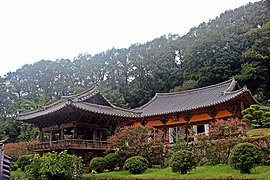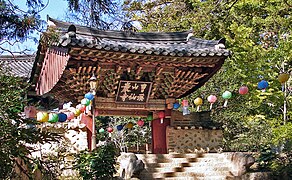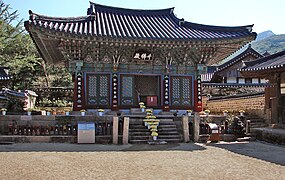Sansa, buddhistické horské kláštery v Koreji
| Sansa, buddhistické horské kláštery v Koreji | |
|---|---|
| Světové dědictví UNESCO | |
 | |
| Smluvní stát | |
| Souřadnice | 34°59′48″ s. š., 127°19′52″ v. d. |
| Typ | kulturní dědictví |
| Kritérium | iii |
| Odkaz | 1562 (anglicky) |
| Zařazení do seznamu | |
| Zařazení | 2018 (42. zasedání) |
Sansa, buddhistické horské kláštery v Koreji je pojmenování pro skupinu sedmi klášterů, které byly společně v červnu 2018 zapsány na seznam světového kulturního dědictví UNESCO. Kláštery byly založeny v období tří korejských království, ale provoz se ustálil až ve středním období vlády dynastie Čoson.
Buddhismus přišel do Koreje ve 4. století a následně byl přijat všemi třemi královstvími (Kogurjo, Pekče a Silla) a vzkvétal jako státní náboženství po dobu přibližně 1000 let, především v období do konce vlády dynastie Korjo.[1] Podpora státní správy výrazně přispěla k šíření buddhistické kultury, vytváření hmotného a nehmotného kulturního dědictví a k rozvoji spevifického architektonického stylu a technologie. Sansa, buddhistické horské kláštery v Koreji se liší od ostatních buddhistických klášterů v zemi, i díky integraci buddhistické víry a doktrín a domorodých náboženských vyznání. Všechny tyto kláštery jsou považovány za jedinečné ukázky citlivé výstavby a rozmístění náboženských staveb do okolního přírodního prostředí zalesněných hor.[2]
Lokalizace klášterů
Kláštery jsou rozprostřeny po celém území Jižní Koreje.
| Klášter | Provincie | Lokalizace |
|---|---|---|
| Buseoksa | Severní Kjongsang | 36°59′56″ s. š., 128°41′15″ v. d. |
| Tongdosa | Jižní Kjongsang | 35°29′17″ s. š., 129°3′53″ v. d. |
| Bongjeongsa | Severní Kjongsang | 36°39′12″ s. š., 128°39′43″ v. d. |
| Beopjusa | Severní Čchungčchong | 36°32′32″ s. š., 127°50′2″ v. d. |
| Magoksa | Jižní Čchungčchong | 36°33′32″ s. š., 127°0′44″ v. d. |
| Seonamsa | Jižní Čolla | 34°59′48″ s. š., 127°19′52″ v. d. |
| Daeheungsa | Jižní Čolla | 34°28′36″ s. š., 126°37′ v. d. |
Fotogalerie
Reference
- ↑ Definition [online]. Sansa, Buddhist Mountain Monasteries in Korea [cit. 2018-07-01]. Dostupné online. (anglicky)
- ↑ Traditional Buddhist Mountain Temples of Korea (2013) [online]. Nationals symbols of South Korea, Cultural Heritage Administation [cit. 2017-02-25]. Dostupné online. (anglicky)
Externí odkazy
 Obrázky, zvuky či videa k tématu Buddhistické horské kláštery v Koreji na Wikimedia Commons
Obrázky, zvuky či videa k tématu Buddhistické horské kláštery v Koreji na Wikimedia Commons
Média použitá na této stránce
Autor: Steve46814, Licence: CC BY-SA 3.0
Palsangjeon (Hall of Eight Pictures) is located at Beopjusa (Buddhist temple) originally built in 553, rebuilt beginning in 1605 being completed in 1626, and renovated again in 1968.
Palsangjeon is a five story wooden pagoda with the four interior walls having paintings depicting the life of Buddha.
Palsangjeon is National Treasure of Korea #55.Autor: Jjw, Licence: CC BY-SA 3.0
Magoksa_Deagwangbojeon, Korea national treasure number 802
Autor: G41rn8, Licence: CC BY-SA 4.0
Gate of Non-Duality at Tongdosa temple.
Autor: Steve46814, Licence: CC BY-SA 3.0
Bongjeongsa Manseru
Bongjeongsa is located at the southern foot of Mt. Cheondungsan, 16 kilometers northwest of Andong city. It was built by the Buddhist Priest Uisangchosa in 672 A.D. As the oldest wooden structure in Korea, it has historic and academic significance. Many important cultural properties, such as Gukrakjeon Hall, Daeungjeon (main prayer hall), Hwaomgangdang Hall, Gogumdang Hall and Muryanghaehoedang Hall are located in the temple compound. In particular, Gukrakjeon Hall is noteworthy, because it clearly shows unique Shilla architectural design unlike most other buildings which adopted Chinese designs.Autor: 최옥석, Licence: CC BY-SA 4.0
Tento obrázek zobrazuje kulturní památku Jižní Koreje s identifikačním číslem
Autor: Steve46814, Licence: CC BY-SA 3.0
Seonam Temple, Seonamsa, is a Korean Buddhist temple located on the eastern slope at the west end of Mount Jogyesan Provincial Park, within the northern Seungjumyeon District of the city of Suncheon, Jeollanamdo Province, South Korea.
The name Seonam (Heavenly Rock) is derived from the legend that a heavenly being once played the game of Go here.
Legend states that in 529 CE missionary-monk Ado built a hermitage at this site on the eastern slope of Jogyesan and named it Biroam.
350 years later in 861 National Master Doseon Guksa constructed a grand temple here and named it Seonamsa.Autor: steve46814, Licence: CC BY-SA 3.0
Daeheungsa is a Korean Buddhist temple located on the slopes of Duryunsan (Mountain), Haenam County, South Jeolla Province, South Korea. Daeheungsa is believed to date to the Three Kingdoms period (4th-9th centuries CE), probably established in 514.
Autor: Steve46814, Licence: CC BY-SA 3.0
Iljumun is the first gate at the entrance to many Korean Buddhist temples. Called the "one-pillar gate", because when viewed from the side the gate appears to be supported by a single pillar.
The plaque reads (vertically from upper right) Jogyesan Seonamsa (曺溪山 仙巖寺), meaning ‘Seonam Temple on Mount Jogye’.
According to the records from the "Message for the framework-raising ceremony of Jogye Gate" the original structure was destroyed by fire and restored in 1540. It was also recorded that the gate was again destroyed during the Byeongja Horan battle and rebuilt in 1719.
Seonamsa Iljumun, One-Pillar Gate, dates back to the Joseon Dynasty and is Cultural Treasure #96.

















